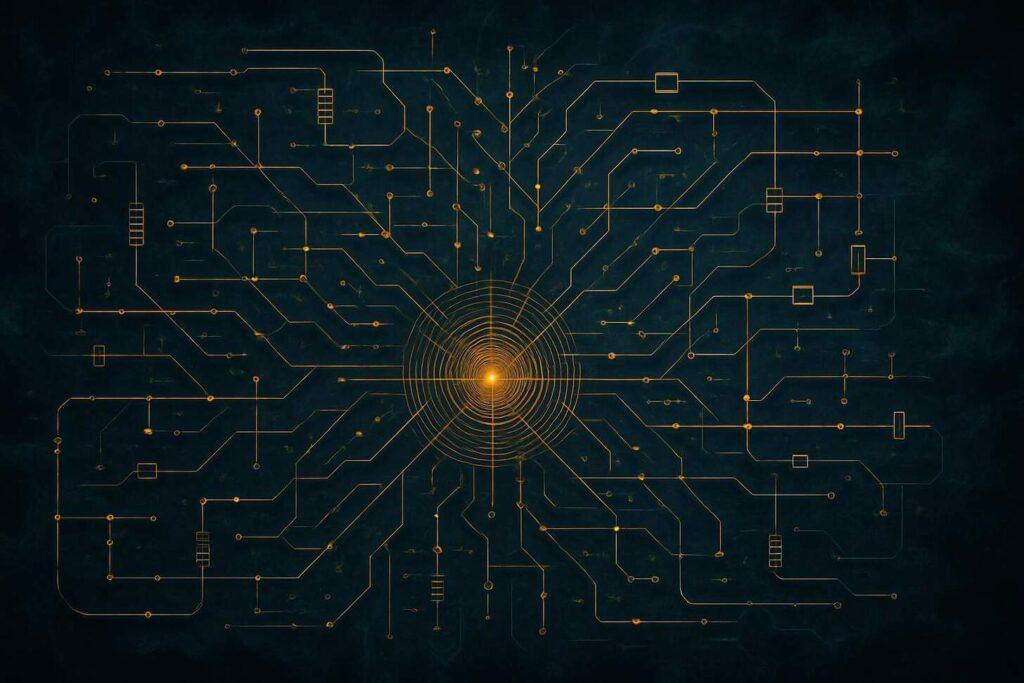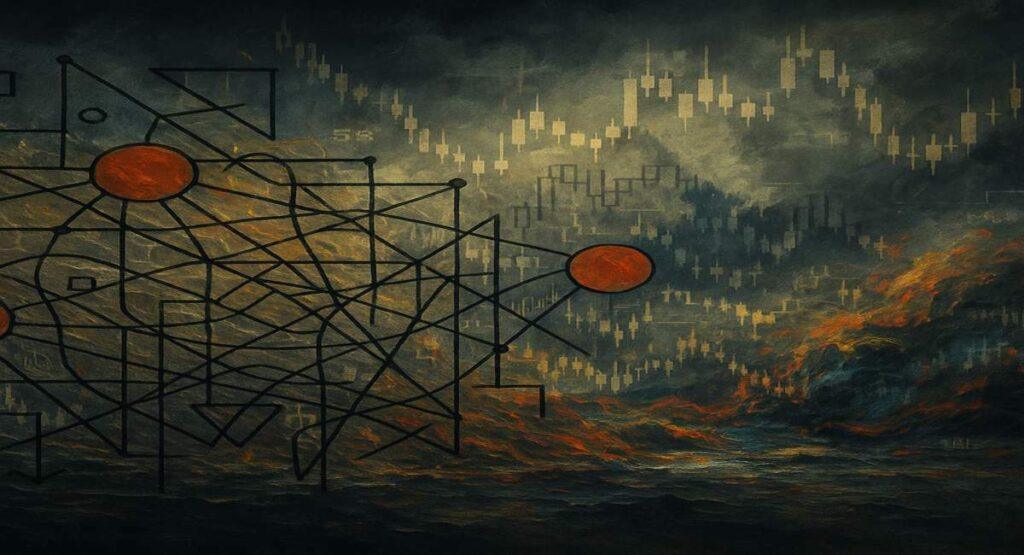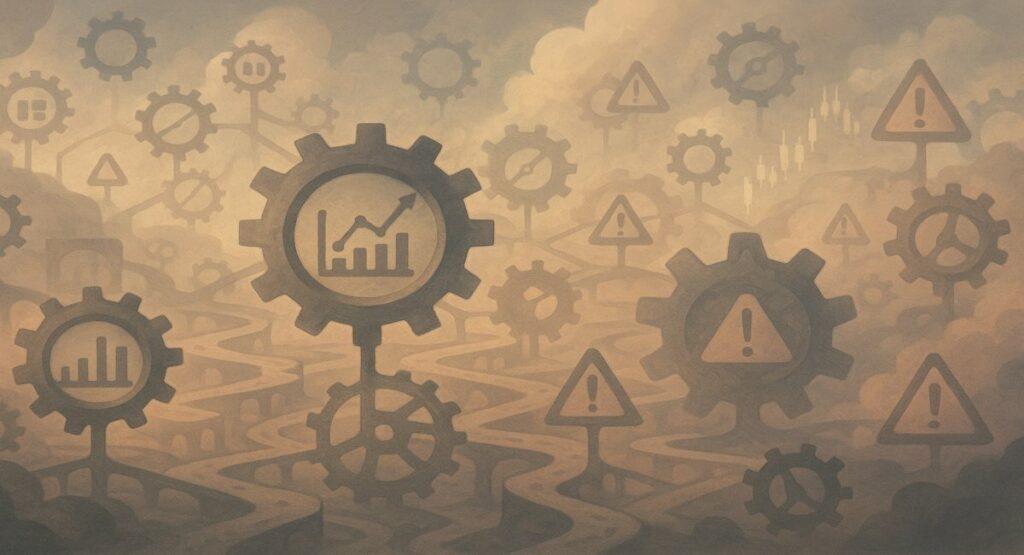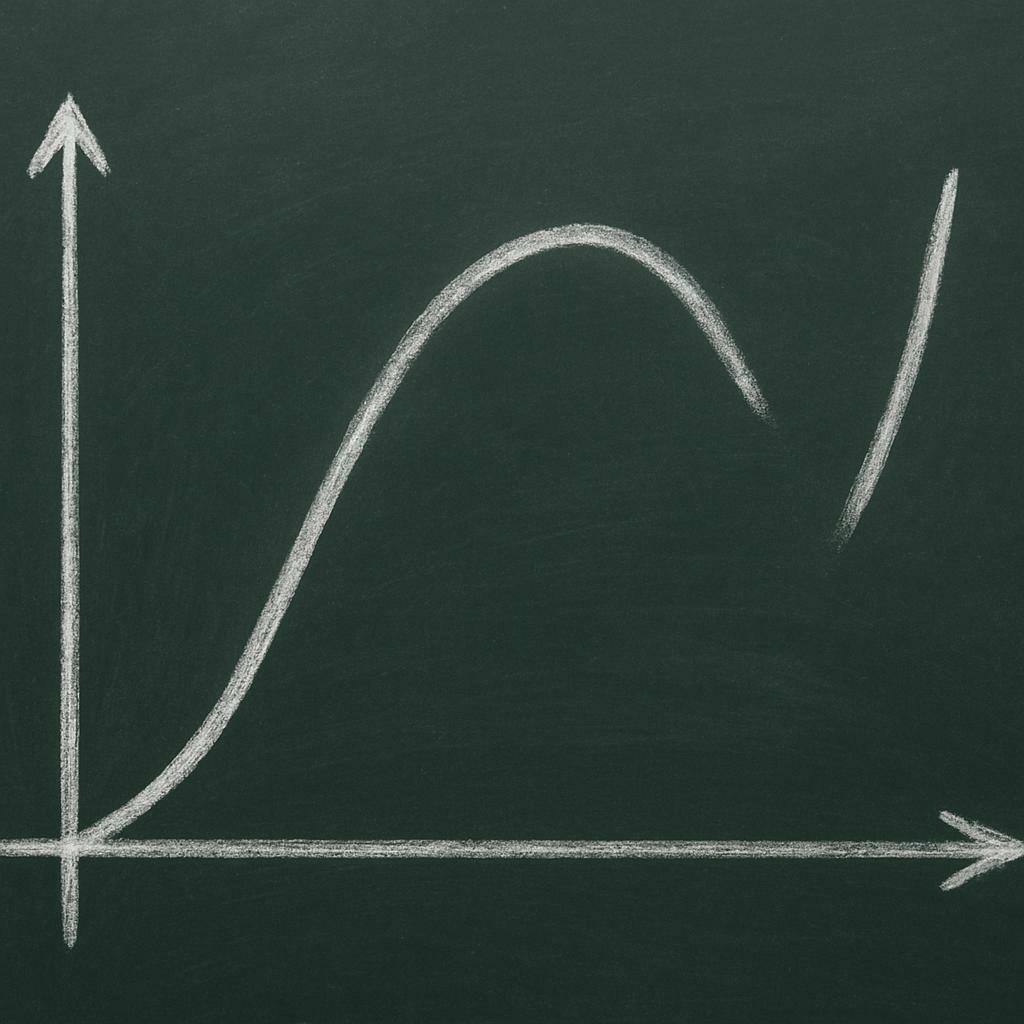Why do tiny actions sometimes create massive ripple effects? The nonlinearity mental model helps explain how small shifts—like a single bank collapse or a cough in a crowded market—can spiral into global crises.
This way of thinking shows that not all causes and effects are proportional, reshaping how we approach problems in finance, health, and even daily decisions.
Take the 2008 financial crash: risky mortgages seemed isolated but triggered a worldwide recession. Similarly, COVID-19’s rapid spread defied simple predictions because each infection multiplied exponentially. These examples reveal patterns where minor events ignite outsized consequences—a core idea from chaos theory and systems thinking.
Rooted in fields like cybernetics, this approach teaches us to spot hidden connections. For instance, engineers now design bridges with “failure buffers” after studying how tiny cracks lead to collapses. Ecologists use similar logic to predict tipping points in ecosystems.
Could recognizing these patterns help you avoid unexpected pitfalls? Understanding nonlinearity isn’t just for experts—it’s a tool for navigating modern complexity. Let’s explore how this mindset applies to work, relationships, and problem-solving.
Key Takeaways
- The nonlinearity mental model: Small actions often create unpredictable large-scale effects
- Real-world examples include financial crashes and disease spread
- Originates from chaos theory and systems science
- Helps anticipate engineering failures and ecological shifts
- Practical tool for everyday decision-making
Overview of the Nonlinearity Mental Model
How do minor shifts snowball into global events? This framework explains why causes and effects rarely match in scale. Imagine dropping a pebble that starts an avalanche—small triggers can rewrite entire systems.
Born from 20th-century science, it challenges the old belief that “big problems need big solutions.” Understanding these mental models helps us navigate the world and the complex things that influence our lives.
Nonlinearity Mental Model: Definition and Origins
Three pioneers reshaped how we see patterns in the complexity of the world. Ludwig von Bertalanffy founded systems theory, showing how parts interact in living organisms. Norbert Wiener’s cybernetics revealed feedback loops in machines and nature.
Edward Lorenz proved a butterfly’s flap could alter weather—the “butterfly effect.” Together, they moved us from linear “A causes B” thinking to studying webs of influence and understanding mental models.
Importance in Understanding Complex Systems
Why do traffic jams form out of nowhere? Why do markets crash after steady growth? This approach answers such puzzles. It teaches us to value first principles—the basic truths shaping systems. Like knowing a single spark can burn a forest, even if flames seem sudden.
| Linear Thinking | Systems Thinking |
|---|---|
| Predictable outcomes | Emergent patterns |
| Focuses on parts | Studies connections |
| “Fix it when broken” | “Prevent cascades” |
Over the long run, small changes in habits or policies create a sense of tipping points over time. A daily 1% improvement in the way people approach their tasks compounds into 37x growth yearly.
Similarly, unnoticed cracks in complex systems, like dams, lead to catastrophic failures. By mapping these hidden pathways and understanding the complexity of our choices, we make smarter decisions in work, health, and relationships.
Core Concepts in Nonlinear Thinking

Ever noticed how a minor change can flip everything upside down? This happens when parts of a system are tightly linked. Like dominoes, one piece affects others in ways that multiply—or shrink—over time. To grasp this, we’ll explore two ideas that shape how nonlinear thinking works in real life.
Interconnectedness and Feedback Loops
Everything’s connected. A tree’s roots stabilize soil, which affects water flow, which impacts nearby farms. These links create feedback loops—cycles where actions circle back. Positive loops amplify changes.
Think of wildfires: heat dries plants, fueling bigger flames. Negative loops balance things. Your body sweats to cool down when hot.
Tech systems show this too. Firewalls block threats, but hackers adapt, forcing smarter defenses. Economies? Panic selling lowers stock prices, causing more panic. Spotting these loops helps in making decisions that either calm or steer the storm.
Emergent Patterns and Tipping Points
Simple rules can create surprises. Birds follow basic flight cues, yet flocks twist in stunning shapes. Markets rise steadily—until a rumor triggers a crash. These are emergent patterns, behaviors no single part planned.
Tipping points mark irreversible shifts. Melting polar ice reduces sunlight reflection, speeding up warming. One degree too many, and coral reefs vanish. By watching for these thresholds, we prepare instead of react.
Have you seen a small habit—like daily walks—transform someone’s health? Or a team’s mood shift after one honest talk? That’s nonlinear thinking in action. What loops or patterns shape your world?
Nonlinearity Mental Model and Changes
Have you ever planted a seed and watched it grow into something far bigger than expected? That’s how cause and effect often work in our world—small starters lead to massive endings.
A single policy change, like cutting interest rates, might seem harmless at first. But over time, it could spark a housing boom or crash entire markets.
Think about traffic jams. One driver tapping brakes creates a ripple effect miles back. Hours later, thousands sit gridlocked.
This mismatch between action and outcome appears everywhere—from climate shifts to viral tweets. The world operates on delayed reactions and hidden connections.
Engineers learned this after bridge cables snapped from tiny rust spots. Ecologists track how removing one species collapses food webs. Even in daily life—skipping workouts for a month might show no change, until suddenly energy plummets.
Why do things escalate unpredictably? Systems have memory. Effects compound. A loan default today becomes a bank crisis next year. By recognizing these patterns, we spot risks earlier. Ever notice how friendships deepen after one meaningful talk?
Or how a rainy weekend alters vacation plans?
Look around. What small choices in your world might rewrite the story?
Nonlinearity Mental Model in Finance

What happens when a few bad loans topple the global economy? The 2008 crisis showed how small risks in financial models can explode into worldwide disasters. Banks assumed mortgage defaults would stay isolated—like a single spark in a damp forest.
But when thousands of homeowners defaulted, the flames spread through interconnected markets, illustrating the importance of mental models in our understanding of how the world changes.
Subprime Mortgage Defaults and Global Impacts
Imagine buying a house with shaky credit. Now multiply that by millions. Banks bundled these risky loans into “safe” investments, but when payments stopped, the dominoes fell. Stock markets crashed. Retirement funds vanished. Even people with good credit lost jobs as businesses folded.
Why did models miss this? They treated risks as separate events, not connected chains. A family’s missed payment in Florida affected pensions in Norway. Today, smarter tools track how decisions ripple through banks, jobs, and daily life.
Ever wonder how your mortgage affects someone overseas? Modern finance links us all. By understanding these hidden ties, we can spot dangers earlier—like noticing storm clouds before the downpour.
Disease Outbreaks and Exponential Spread

What begins as a single cough in a crowded room can grow into a global health crisis? This effect of exponential spread defines modern pandemics. Unlike linear growth—where cases rise steadily—diseases multiply through networks, challenging our thinking about how these things spread across the world.
One infected person might pass it to three others, who each infect three more. Within weeks, thousands of people are affected.
COVID-19 and the Role of R0 Values
The COVID-19 pandemic showed how quickly small changes in transmission rates alter outcomes. Scientists use R0 (“R-naught”) to measure spread potential. An R0 of 3 means each case creates three new infections. Early COVID strains had R0 values between 2-3, but variants like Delta reached 5-8.
Linear risk assessments failed because they underestimated connections between people. A 2020 study found that 80% of transmissions came from just 10-20% of carriers. This uneven pattern meant isolated cases could ignite outbreaks anywhere.
| Linear Risk Model | Nonlinear Reality |
|---|---|
| Assumes fixed case numbers | Accounts for clusters and super-spreaders |
| Focuses on individual actions | Tracks community interactions |
| Uses historical data | Models multiple future scenarios |
Why did mask mandates and lockdowns work better in some regions? Decisions that reduced contact rates (like closing theaters) lowered R0 values faster than expected. A 1% drop in daily interactions could cut total cases by 30% over months.
Ever notice how quickly a campfire grows? Disease spread works similarly—small sparks need immediate attention. By planning for exponential change, communities build defenses before crises escalate.
Engineering and Infrastructure Risks

How can a single cracked pipe lead to a nuclear disaster? In 2011, Japan’s Fukushima plant faced this exact scenario. A 9.0 earthquake triggered a 45-foot tsunami—breaching seawalls designed for smaller waves.
The flooding knocked out power, causing reactor meltdowns. This chain reaction shows how engineering systems fail suddenly when stress crosses critical thresholds.
Materials like steel or concrete handle steady pressure—until they don’t. Research shows structures withstand moderate shocks but collapse catastrophically beyond set limits.
Think of a bridge cracking under one extra truckload. These tipping points hide in plain sight, masked by everyday stability.
| Linear Engineering | Systems Approach |
|---|---|
| Tests individual parts | Simulates interactions |
| Assumes fixed safety margins | Plans for cascade effects |
| Repairs after failure | Builds redundancy buffers |
Fukushima’s seawalls worked—until they didn’t. Backup generators failed because nobody imagined flooding and power loss. Modern designs now account for linked risks. For example, skyscrapers use base isolators to absorb quakes, while grids reroute power automatically during storms.
Why does this complexity matter? A small design flaw can ripple through interconnected systems. Engineers now model how pipe leaks affect electrical systems or how traffic jams strain bridges.
This shift prevents surprises—like catching a loose bolt before the wheels fall off.
Ever seen a pothole grow into a sinkhole? Or a blackout spread across states? These aren’t random events. They’re warnings to work with nature’s unpredictability, not against it. How might your local infrastructure handle hidden stresses?
Ecological Thresholds and Collapses

What transforms a thriving ocean into a dead zone? Ecological thresholds act like invisible tripwires—cross them, and systems collapse unexpectedly. These tipping points occur when small stresses, like overfishing or pollution, push ecosystems past recovery limits.
Once breached, changes become irreversible, even if the original pressure stops. This idea makes sense when thinking about the long-term effects over time; the point is that these problems can escalate quickly through a different lens.
When Fishing Policies Ignored Warning Signs
For centuries, North Atlantic cod fed millions. By the 1980s, advanced trawlers caught fish faster than they reproduced. Scientists warned of collapse, but quotas stayed high.
By 1992, cod populations dropped 99%, wiping out 40,000 jobs overnight. This wasn’t just bad luck—it was a power struggle between short-term profits and long-term survival.
Three critical errors caused the crash:
- Ignoring how small catch increases eroded breeding stocks
- Assuming oceans could endlessly absorb pressure
- Delaying action until collapse was unavoidable
Today, some cod stocks have rebounded by 30% through strict quotas and habitat protection. This turnaround shows how adaptive ideas—like seasonal fishing bans—can restore balance. But recovery took decades, proving prevention beats cure.
Why does this concept matter for forests or coral reefs? Like a Jenga tower, ecosystems withstand removals until one block topples everything. Smart policies now use “buffer zones” to stay clear of thresholds. For example, setting catch limits 20% below estimated safe levels.
Ever wonder how your seafood choices affect ocean health? Small decisions—like choosing sustainably caught fish—add up. What tipping points might your daily habits influence?
Nonlinearity in Risk Management and Policy

Why do safety rules written in peacetime fail during crises? Traditional risk plans often assume steady progress—like expecting storms to match historical patterns.
But real-world dangers twist and surge unpredictably. This gap between theory and reality explains why linear models leave us unprepared for sudden disasters.
Nonlinearity Mental Model: Underrating Risks
Many policies use straight-line math: “If X happens, we’ll do Y.” But complex systems don’t work that way. Cities built flood walls for 100-year storms now face 500-year deluges yearly. Why? Climate shifts create feedback loops—warmer air holds more moisture, fueling bigger rains.
In 2005, New Orleans’ levees were designed for Category 3 hurricanes. Katrina hit as Category 5. The damage? $125 billion. Linear plans gave false confidence. They missed how small temperature rises could rewrite weather rules.
Designing Adaptive Regulatory Systems
Smart policies now treat risks like shifting tides, not fixed markers. California’s wildfire codes update yearly based on drought data. Banks run “stress tests” imagining market crashes worse than 2008. These actions build buffers against surprises.
Three keys to regulatory success:
- Real-time data tracking (like infection rates during pandemics)
- Flexible rules that tighten or loosen based on thresholds
- Regular scenario drills for unlikely-but-catastrophic events
Ever seen a dam hold until one extra storm? Or a vaccine rollout slow a variant? That’s adaptive thinking in action. By planning for jumps and jolts, we make policies that bend instead of break.
Could your community benefit from this approach? What outdated safety sense needs updating where you live?
Systems Thinking and Mental Models

What do 1940s missile systems have to do with modern decision-making? The roots of systems thinking stretch back to wartime innovations. Scientists like Norbert Wiener studied how machines and living things adapt through feedback—work that became cybernetics.
Edward Lorenz later showed how tiny data shifts (like rounding errors) could flip weather predictions entirely. These breakthroughs taught us to see patterns, not just parts.
Historical Foundations and First Principles
First principles act like building blocks for understanding complexity. Imagine explaining a forest fire: linear thinking blames the spark. Systems thinkers study dry brush, wind patterns, and firefighter response times.
Early pioneers focused on these core truths:
- Wiener’s feedback loops (thermostats adjusting room temps)
- Lorenz’s chaos theory (a butterfly’s wings affecting storms)
- Bertalanffy’s general systems theory (how organs cooperate)
This shift helped experts predict growth patterns in economies and ecosystems. For example, knowing fish populations rebound slowly after overfishing.
Integration With Cybernetics and Chaos Theory
Cybernetics revealed how systems self-correct. Your car’s cruise control speeds up or slows down based on hills—a real-time feedback loop. Chaos theory explained why small effects sometimes rewrite entire systems.
A single delayed train can cause hours of subway backups.
| Traditional Approach | Systems Method |
|---|---|
| Fixes one problem at a time | Maps ripple effects |
| Uses static data | Tracks dynamic changes |
| Ignores hidden connections | Finds leverage points |
Today, these ideas help cities manage traffic and doctors personalize treatments. By spotting critical points where small actions create big shifts, we make choices that respect life’s interconnected nature. How might this apply to your daily choices?
Making Decisions During Uncertainty

How do seasoned firefighters make split-second choices in burning buildings? When smoke clouds vision and time runs short, they blend instinct with pattern recognition—a skill we all need in unpredictable situations.
Life rarely gives perfect data, but paying attention to feedback loops helps us course-correct like pilots navigating storms.
Leveraging Feedback Loops for Better Choices
Feedback loops act like invisible guides. A therapist might notice a client’s subtle shifts in tone—signaling hidden progress. Businesses track customer reactions to tweak products weekly. These skills turn vague signals into clear paths forward.
Consider sudden breakthroughs in therapy. Research from Frontiers in Psychology shows how therapists adapt when clients hit emotional tipping points. One gentle question can unlock years of growth—like finding the right key for a stuck lock.
Three ways to sharpen intuition:
- Track small changes in routines (sleep patterns, work focus)
- Notice repeating patterns in relationships or projects
- Test quick adjustments and watch results
Ever changed a meeting time and seen teamwork improve? Or adjusted a recipe based on a friend’s frown? That’s feedback in action. While data matters, instinct often spots risks screens miss—like a hunch to delay a launch during market turbulence.
Balance matters. Stock traders use algorithms but also watch trader chatter for panic signals. Nurses combine test results with patient body language. What mix of gut feelings and facts guides your toughest choices?
Nonlinearity in Therapy and Life Changes

When does a single conversation change someone’s life forever? In therapy, breakthroughs often arrive suddenly—like sunlight breaking through storm clouds. Healing rarely follows straight paths.
Research shows people might feel stuck for weeks, then experience dramatic shifts overnight. These moments reveal how personal growth works in jumps, not just slow steps.
Sudden Gains, Depression Spikes, and Critical Fluctuations
Imagine tracking your mood on a chart. Most days show small ups and downs. Then—boom—a week of crushing sadness hits. Or you wake up feeling lighter, as if a weight vanished. Therapists call these “critical fluctuations”—chaotic periods before major shifts.
A 2019 study found clients who had sudden improvements kept their gains longer than those with steady progress.
Why does this matter? It changes how we approach tough times. That dark week might signal you’re nearing a breakthrough, not failing. Like earthquakes releasing built-up pressure, emotional spikes can clear the way for new ideas.
Transformative Processes in Therapy
Skilled therapists use specific tools to navigate these twists. They might:
- Track sleep patterns or energy shifts as early warning signs
- Introduce mindfulness exercises during unstable phases
- Celebrate small wins that hint at bigger changes ahead
Consider Sarah, who felt anxious for months. One session, she recalled a childhood memory—and everything clicked. By leaning into that turbulence instead of avoiding it, she rebuilt her confidence.
This approach works because it respects our natural rhythms, not forced timelines.
Ever had a friend say, “I just woke up different”? That’s nonlinear change in action. By noticing these patterns, we can weather storms knowing calm often follows chaos. What small shifts in your life might be preparing you for growth?
Applications in Business Strategy

How do companies like Netflix thrive while others fade? Traditional plans often miss hidden connections between customer habits, tech shifts, and global trends. By viewing markets through a multifaceted lens, leaders spot opportunities invisible to linear thinkers.
Anticipating Disruptions and Fostering Innovation
Charlie Munger, Warren Buffett’s partner, built his success on a “latticework” of ideas. He combines psychology, economics, and physics to solve complex problems.
When Blockbuster ignored streaming’s early signals, Netflix adapted—turning a mail-order service into a global giant. Small bets often deliver value far beyond their cost.
| Traditional Approach | Systems Approach |
|---|---|
| Focuses on parts | Maps connections |
| Relies on historical data | Plans for scenarios |
| Fixes single issues | Creates adaptive loops |
Three ways to apply this today:
- Track weak signals (like niche forums predicting trends)
- Reward teams for testing small, fast experiments
- Use “pre-mortems” to imagine future failures
What separates thriving companies from those stuck in old patterns? They treat uncertainty as fertile ground. A 5% budget shift toward R&D might unlock breakthroughs competitors can’t copy. Even customer complaints become clues for reinvention.
Ever noticed how one policy change—like remote work—reshaped entire industries? Your next pivot could start with a single question: What small shift might rewrite your business story?
Personal Growth Through Nonlinear Thinking

What if your next small step changed everything? Life rarely follows straight paths—a job loss might lead to a new passion, or a chance conversation could spark a lifelong friendship. These events remind us that growth often comes in bursts, not steady climbs.
Consider post-traumatic growth studies. Research shows people who face crises often experience sudden leaps in resilience—like discovering strength they never knew existed.
One therapy session might seem uneventful, but weeks later, a client realizes they’ve rewritten their entire story. It’s not magic—it’s how small interactions compound over time.
Daily habits work the same way. Walking 10 minutes daily feels trivial until energy levels jump after three months. A weekly gratitude practice might suddenly shift your outlook during tough times. These outcomes remind us to trust the process, even when progress hides.
Three ways to embrace nonlinear growth:
- Notice “quiet wins”—like feeling calmer during stress
- Reframe setbacks as feedback, not failure
- Celebrate pivots—changed goals often lead to better results
Ever had a hobby unexpectedly improve your work skills? Or a breakup that clarified what you truly value? Life’s twists aren’t random—they’re invitations to adapt. By watching for patterns in your journey, you spot opportunities hidden in chaos.
What tiny step could start your next big leap?
Better Decisions with Mental Models

What separates great decisions from costly mistakes? Often, it’s the tools we use to analyze challenges. Like a chef needing knives, pans, and thermometers, thinkers thrive when combining multiple frameworks. This approach builds a clearer map of reality—one that exposes hidden risks and opportunities.
Insights from Charlie Munger’s Latticework
Charlie Munger, Warren Buffett’s business partner, credits his success to a “latticework” of theories. He blends ideas from psychology, economics, and physics. For example, when evaluating a company, he considers market trends and human behavior patterns. This analysis avoids blind spots that single-perspective thinking creates.
Munger compares using one model to “a man with a hammer”—everything looks like a nail. His method? Study 80-90 key theories across disciplines. A 2021 study found teams using diverse frameworks made 34% fewer errors in strategic choices.
Overcoming Cognitive Biases with Diverse Tools
Our brains love shortcuts, but biases like confirmation bias or anchoring distort decisions. Using multiple maps acts like a reality check. This point becomes clear when you imagine planning a road trip with GPS, paper maps, and local advice—you’ll avoid wrong turns faster.
The concept of integrating various tools enhances your decision-making process.
| Single Approach | Multi-Model Approach |
|---|---|
| Misses hidden risks | Reveals blind spots |
| Stuck in echo chambers | Challenges assumptions |
| Limited adaptability | Flexible strategies |
Ever noticed how using just one tool limits your perspective?
Try pairing economic analysis with historical patterns. Test decisions through engineering and artistic lenses. Small shifts in your thinking toolkit can lead to breakthroughs.
What biases might you counter by adding one new theory to your next big choice?
Thinking Nonlinear in Daily Life

How can a morning coffee routine reshape your entire day? Small habits often create ripple effects that surprise us. By spotting patterns in daily choices, you turn ordinary moments into growth opportunities.
Practical Tools and Strategies for Daily Decisions
Start with feedback tracking. Jot down three daily wins and their unexpected outcomes. Did skipping social media boost work focus? Did a 10-minute walk improve afternoon mood? These micro-observations reveal hidden connections.
Try the “5 Whys” technique. When stuck, ask “Why?” five times to uncover root causes. A missed deadline might trace back to poor sleep habits weeks earlier. This approach aligns with systems thinking principles used in engineering and ecology.
| Linear Habit | Nonlinear Adjustment |
|---|---|
| Set fixed daily goals | Track cascading effects |
| Blame single factors | Map multi-cause chains |
| Repeat old routines | Test tiny experiments |
Notice compounding patterns. Reading 15 minutes daily seems small but builds to 91 hours yearly—enough for 18 books. Similarly, weekly family dinners strengthen bonds that weather future conflicts.
Ever tried “habit stacking”? Pair new routines with existing ones. Stretch while coffee brews. Reflect on gratitude during commutes. These habits leverage existing neural pathways, making changes stick faster.
Ready to experiment? Choose one example this week—like tracking screen time triggers. Share your discoveries. Sometimes the smallest shift lights the biggest fire.
Conclusion
What if a single choice could reshape your entire future? This article revealed how small actions—from mortgage defaults to daily habits—create ripple effects across diverse fields.
Financial meltdowns, health crises, and engineering disasters all share a hidden truth: causes and effects rarely match in scale.
Real-world examples proved why linear plans fail. Stock markets crash after steady growth. Viruses spread faster than models predict. Coral reefs collapse from overlooked pollution. Yet these patterns also offer hope—by spotting feedback loops and tipping points, we make smarter choices.
Managing biases remains critical. Combining multiple perspectives—like Charlie Munger’s latticework approach—helps avoid blind spots. Whether navigating markets or personal growth, staying adaptable beats rigid plans.
Your next breakthrough might start with a simple question: What connections am I missing? Keep refining your toolkit, and watch how unseen patterns shape outcomes. Stay curious, stay adaptable—the world rewards those who think in systems, not straight lines.


